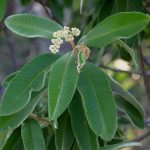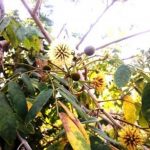TREE LIFE
SEPTEMBER 1989
MASHONALAND CALENDAR
Tuesday 5th September: Botanic Garden Walk. Meet in the Car Park at 1645 for 1700. We hope that Tom Muller will be able to spare the time to guide us around.
Saturday 16th September and Sunday 17th September: We will be visiting Karoi on Saturday to meet the folk there. The intention is to accompany our hosts to a venue of their choice, meeting at the Karoi Hotel at 1430 hours. Accommodation will be available for those wishing to spend the night in Karoi prior to leaving early on Sunday morning for the Dichwe Lemon Forest on Mr J. Brown’s farm in Mhangura. We have been to Dichwe before but are drawn back to this unique spot. This is an area of forest giants like Khaya nyasica (the big tree of Chirinda forest). The lemons, which have become naturalised in the forest are thought to have come in on Arab or Portuguese trade routes. Please phone Maureen Silva Jones at work on 739711 before 11 September, if you require accommodation in Karoi.
For those members who are only able to come on Sunday to Dichwe, a bus has been arranged which will leave the Monomatapa Car Park on Sunday at 0745 hours.
Saturday 23rd September : Mukuvisi Woodlands walk. Meet at the Paget Road/Inyanga Crescent gate at 1500 hours.
MATABELELAND CALENDAR
On Sunday, 3rd September we go to Guy Acutt’s farm “Kenmap” on the Kenyame River, 29km out on the Queen’s Road (beyond the Airport). We have decided to make this a morning only trip and to meet at City Hall car park (lifts already arranged), at 0830 hours.
Sunday, 17th September: An extra outing for those energetic enough to attempt the walk to Inanke Cave, near Toghwana Dam, Matopos. An all day outing, take a small lunch and we will have it at the cave. Meet EARLY at Retreat Shopping Centre at 0700 hours.
MATABELELAND NOTES
Rather than a Tree Outing, our trip on Sunday 6th August became a grand tour of the lesser known parts of Matopos. Starting out long the Plumtree Road, and noting the many Acacia robusta subsp. robusta, we turned off near Figtree and took time off to watch a Black Eagle settle on its nest, and to admire the beautiful flowering Aloe excelsa and A. aculeata, and also to marvel at the fine fruiting of the Pterocarpus angolensis with their very many “hedgehog on a raft” seed pods, and Gardenia volkensii laden with the ridged grey fruit.
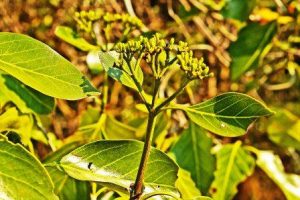
Tarenna zimbabwensis. Photo: Meg Palgrave. Source: Flora of Zimbabwe
The main emphasis on this outing was to visit a relict colony of Euphorbia confinalis subsp. rhodesiaca which only occur in this area. The excellent talk given by Norma Hughes, ably assisted by octogenarian Wendy Bullock, mentioned that they grow to a height of about 10 meters, they are very poisonous and that they branch out of the main stem, and again form a shape like that of the Jewish Candles, and that they do not have leaves, but ‘swollen stems’ (trying saying that about 10 times). Tea break was taken near some very large Diospyros mespiliformis, during which we had a discussion on the identification of Tarenna zimbabwensis and T. neurophylla, comparing them with Canthium lactescens – all RUBIACEAE, but on a good specimen, milk can be squeezed out of the ‘assegai’ of the Canthium. Leader, Geoff Archer, pointed out the position of Hendrik’s Pass and some history pertaining thereto, but we found that new road building had by-passed the actual spot. Back tracking to Badza village, we embarked on a new road through the communal lands showing marked land degradation, but luckily Sclerocarya birrea, Parinari curatellifolia, Piliostigma thonningii and Strychnos spinosa, because of their various uses, were intact. The autumn colours of the Pseudolachnostylis maprouneifolia, Croton gratissimus, Terminalia randii, Faurea saligna and Burkea africana were quite breath taking and we were rather pleased that there was so much greenery and flowering due to the late rains, namely Nuxia oppositifolia, Ziziphus mucronata, Pappea capensis, Ficus ingens and Combretum hereroense.
Closer to Silozwane Cave we drove through a “maze” of very tall Dodonaea viscose and after lunch the ascent was attempted by the intrepid, led by a welcome ‘shifty shona’ member, barefooted John Stanton. Stopping for breath is a good excuse for study, and Apodytes dimidiate, Allophylus africanus, Cassine matabelica (with large yellow drupes), Heteropyxis dehniae, Maytenus heterophylla, Pterolobium stellatum (with beautiful red seed pods), Sterculia africana, Vepris reflexa and Pavetta eylesii (with peeling bark) came up at the right times for discussion.
Homewood bound we marvelled at the amount of scenery and rock formations that we had managed to pack into the 200km trip, and the beauty of the trees even in dry old Matabeleland.
Bulawayo Discoveries : During July Geoff Archer “discovered” a new Acacia in our area, the Acacia goetzei (purple pod acacia) between the golf driving range and the golf course near Phillips Drive. Much excitement was generated as these have been seen before but not recognised. And we think the Acacia nigrescens was wrongly named at Engomeni Game Reserve, Fort Rixon, should be the Acacia burkei. Ah well, it could mean another trip!!
-Ken Blake.
BOTANIC GARDEN WALK, AUGUST 1989 : PLANTS AND ANTS
As I have just returned from a conference in Oxford on ‘Plants and Ants” we spent the morning examining these interactions. We are well aware that most of our indigenous trees have nectar glands on the leaves or the leaf stalks. Examples occur on Acacia, Albizia, Newtonia, Cassia, Azanza, Monotes, Parinari and Adenia. Why do plants attract insects, particularly ants, to their leaves? The conference was interesting because before I left I was confused by conflicting reports in the literature, after the conference I was convinced that this confusion is real – the results are sometimes difficult to interpret. Yes, there are cases where plants do seem to benefit from having ants around. The ants kill caterpillars that feed on the leaves. Some ants spend their time cleaning the leaves, they collect caterpillar eggs and throw them over the side of the leaf! Some ants are very aggressive and will attack anything that touches the tree on which they live. But there were a number of papers that showed how ants do not appear to help the tree. If the ants are excluded from the plants there is no difference between the rates at which the leaves are eaten.
Here are some of the highlights. Doctors Rosengren and Syndstrom of Helsinki showed that scotch pines which were visited by red wood ants grew slower than those not visited. These ants tend aphids on the pines.
Drs. Compton and Robertson of Grahamstown showed how bugs (Hilda patruelis) on Ficus sur secrets honeydew from around the fruiting branches. This honeydew attracts ants to the developing fruit. The activity of the ants disturbs those parasitic wasps that lay their eggs through the fig wall. As a result fewer pollinating wasps are parasitized. This was a most exciting paper. Dr. de Vries of Panama discussed the specialized relationships between some butterflies and ants. Normally ants do not tolerate caterpillars, but a few specialized caterpillars secrete chemicals that disguise their smell and they make noises that the ants appear to find attractive. It is most interesting to note that these special caterpillars are most commonly found on plants which have extra floral nectaries. In contrast related caterpillars that cannot soothe ants tend to live on plants without nectaries.
Drs. Rashbrook, Compton and Lawton of Grahamstown have done a lot of work on the nectaries on bracken leaves. Despite an exhaustive study in the USA, UK and SA they find no difference in the amount of leaf material browsed – whether there are ants or not.
Drs Mackay and Whales of tropical Queensland found no difference between the numbers of herbivores on leaves of Macaranga subdentata and Homalanthus populifolius whether ants were present or absent. Both of these species have nectaries on their leaves.
Drs. Fiala, Maschwitz and Pong of Germany and Malaysia reported on ant associations with Macaranga. Many Malaysian species produce special food bodies and feed the ants.
Dr. de Vascencelas of the Amazon showed how important ants can be in getting rid of caterpillars and other herbivores.
Dr. Benzing of Ohio showed how epiphytes (plants living on trees) can be provided with essential nutrients when ants live amongst the roots. The ants bring these nutrients to their nest amongst the roots.
Drs Westoby, Hughes and Rice of Australia showed how many Australian plants have small food bodies on their seeds. The ants collect the seed and the food body and bury these underground. This dispersal by ants is particularly common on poor soils both in Australia and South Africa. Dr. Bond of Cape Town has also been studying these ants as distributers of seeds. They may prevent mice from eating the seeds, particularly in the PROTEACEAE.
Drs. Kaufman, McKay and Horvitz of Florida photographed small food bodies attached to the seeds of Ficus microcarpa. They found that these food bodies were not digested if the seeds were eaten by the Indian Hill Mynah. Instead they remained intact. Ants were attracted by these food bodies, collected the seeds and carried them under ground to their nests. It is exciting to think of a seed passing through a bird then being carried off by an ant. Adding in George Hall’s research into seed distribution by predatory birds and you have – seed eaten by seed eating bird, bird and seed eaten by predatory bird, seed collected into a pellet together with bones and feathers of half digested bird, then ants collecting seed from the pellet and carrying it away underground!!
I presented data on the interaction between ants and Kigelia africana. Here the nectaries are situated on the stipule. My data showed that nectaries are commonly found on saplings and sucker shoots but not adult trees and are most active on young leaves. Once the leaves harden the nectaries stop secreting. A similar pattern occurs in Parinari and Albizia species.
All in all an intense conference that posed more questions than it did answers. K.St..J.D.
TREE-ING IN THE CLOUDS
Sometime ago the Blakes had booked a completely relaxing Heroes weekend at the Vumba, and then the Harare/Ayrshire/Mutare groups decided on the same venue – thanks hey.
Our outward journey took in the new road via Gweru/Mvuma/Chivhu/Buhera/Nyazura and was a great success tree and scenery wise, and we arrived at the booked lodge at Seldomseen in the Vumba in good time.
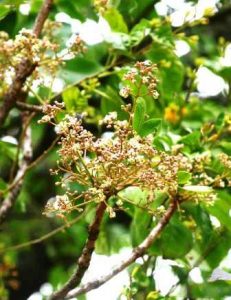
Ekebergia benguelensis. Photo: Bart Wursten. Source: Flora of Zimbabwe
The next day, due to our Nyanga fixation, we were late for the first afternoon outing, but it tended to break us in gently with the erudite types. Saturday was an all day fixture and we did the lot. Bunga forest, the relict section of trees was the object and soon after starting off we were thrown in at the deep end with such newies as Ekebergia benguelensis –very tall with new red/orange opposite leaves with a terminal leaflet; a thrilling Ficus craterostoma with easily recognisable “cut off” leaves; a really exciting Polyscias fulva “Polysky” with a starburst of shiny leaves at the end of a tall smooth branched truck; and a hillside literally covered with Strelitzia nicolai, different from the garden variety, very tall with large banana like leaves.
Coming out onto as promontory of Brachystegia woodland (the view was fantastic), Derek and Jill Henderson from Raffingora threw their arms around an old ‘friend’ Faurea speciosa. “Faurea?” says I disbelievingly – and then Tacky Bannerman from the Vumba embraced an enormous Faurea forticuliflora with large red “bottle brush” flowers – so tall that it is almost impossible to study the leaves. “Faurea?” says I, disbelievingly – these are a whole new scene from the Matabeleland Faurea saligna!
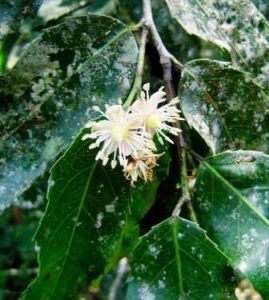
Rawsonia lucida. Photo: Bart Wursten. Source: Flora of Zimbabwe
Various species, such as Rawsonia lucida, like holly with a patchy orange bark; Syzygium masukuense sups. gerrardii with an easily recognisable flat “square” petiole and red leaves; Rauvolfia caffra with its new leaves like green candles standing up and the old leaves hanging down! A beautiful mnemonic was the “hand grenade” fruits of the Myrianthus holstii; the Nuxia congesta with the 3 opposite spirals of leaves; and the wavy leaf margins of the Craibia brevicaudata.
An unusual feature of the Cola greenwayi is the kink where the petiole meets the leaf (pulvinus) which allows the leaf to turn away from the sun. All this information was given to us by Kim Damstra who is never stumped for an answer – I thought, what has Mashonaland done to deserve Kim, then at lunch time stilling under the spiny tree ferns Alsophila manniana, Linda and Mark Hyde produced a fabulous iced birthday cake for him – and I realised that Harare do really appreciate their treasure!
Although there were lots more, by this time not only were our feet and legs giving in, but also the knowledge bumps and from there onwards it was a home run for the cars. We were let off the Sunday morning outing in Mutare, to take up birding (14 lifers in three hours), but we really did enjoy meeting up with the tree types from around the country. On advice from Dick Hicks and Maureen Silva Jones, we took note of the Zebra bark Commiphora (Commiphora merkeri in the Birchenough Bridge area, after having admired the beautiful flowering Acacia nigrescens (knob thorn) between the Adonsona digitata on our way home.
To sum up – a wonderful weekend in a wonderful place in wonderful weather – with some wonderful people. Thank you.
-Ken and Betty Blake.
WALK UP MURAHWA’S HILL
Accompanied by the two small Hyde children who showed convincing evidence of joining the next Olympics, the Tree Society to Murahwa’a Hill, (not very energetically). Murahwa’s Hill is known for the very large variety of species concentrated on a small area of land.
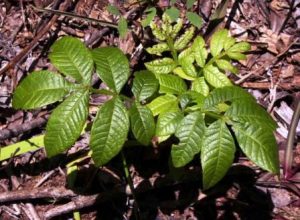
Bersama abyssinica. Photo: Bart Wursten. Source: Flora of Zimbabwe
Climbing upwards, amongst all the plant species, Kim showed us Zanha golungensis, with its growing tip characterised as a black ball and furry claw, Bersama abyssinica with its winged rachis and serrated leaflets. Terminalia gazensis was present, as were Acokanthera oppositifolia (bushman’s arrow poison), Albizia schimperiana (not as keeled as, and a lighter green than gummifera), Craibia brevicaudata, large stands of Teclea nobilis, a variety of Strychnos, one of them being usambarensis, Chaetachme aristata (thorny elm), furry-leaved Celtis africana, Mimusops zeyheri, Ficus thonningii, Maytenus undata with its mousy smell, Ziziphus mucronata subsp. mucronata, a species of Ritchiea which, when bitten, leaves a taste of capers on the teeth, a characteristic of CAPPARACEAE. We ended at a wishing tree, Ficus zanzibarica, unmistakable by the knobs on its trunk which later produces figs. This particular tree was spectacular as it had fallen down and grown roots from the trunk into the soil. The soft mulch had been washed away, leaving the bough on five foot stilts.
It was with regret that we said good-bye to everyone as they departed on their various routes. Thank you all for a fascinating week end.
CHIBVUTI FARM 20TH AUGUST
On 20th August we had the pleasure of visiting Chibvuti Farm, the gracious home of Charles and Bridget Newmarch in the Enterprise farming area.
Tea on the lawn of a beautiful garden preceded our journey through green fields of maturing oats to the game park where we found ourselves amongst a small herd of eland who showed little concern at being stared at by a large herd of humans from close quarters.
A little further on we arrived at a kopje where large trees grew and we started to identify and number these trees for a check list that Charles wanted drawn up. The area contained a remarkable mixture of granite kopje and riverine species, the latter presumably finding ample sustenance from water trapped by the rock base below the surface soil. Thus we found Diospyros natalensis, EBENACEAE, a tree normally associated with granite outcrops, growing next to Olea europaea OLEACEAE, This latter tree was the largest of its species that many members have ever seen. Also outstandingly large were Allophylus africanus, SAPINDACEAE, and Maytenus undata, CELESTRACEAE, the latter recognised by the characteristic musty smell given off when the bloom on the underside of the leaf is rubbed with the fingers. Another unusual member of the EBENACEAE family was Diospyros whyteana, with a hair fringed margin, and strikingly glossy upper surface to the leaves.
Many other species led us around the foot of the kopje to a small frieze of Rock Paintings, remarkably vivid still although enjoying no particular protection from the weather. There were two groups of dancers, wearing aprons, superimposed on a buck with its head turned to look backwards. Amongst one of the groups was a small, rather grotesque figure that appeared to be an authentic party of the group and not a latter day addition.
We were led back to Charles’ 31st dam, (there are 33 altogether on the estate), for lunch, and thereafter split into two groups, the one going off with Charles for a game viewing drive, and the other electing to climb to a view point on the kopje past a further small Rock Painting depicting, in outline, an elephant with several human figures around it (a hunting scene) and another figure apparently pointed on its back.
The grandeur of the view over adjacent farms and bush induced a serenity of mind that brought an interest packed day to a gently close. Thank you, Charles and Bridget, for sharing with us your corner of our lovely country.
D. Hicks
CHIKWENYA NOTES – JUNE/JULY 1989
There are still some Acacia (Faidherbia) albida flowering, and many of them now showing the unripe “apple ring” pods. On Chikwenya Island the A. albida saplings are growing up and thickening out, and becoming a dominant feature in marked contrast to the mainland flood plain, where there is no surviving regeneration.
The baobabs, Adansonia digitata, are stark silhouettes, totally bare of leaves. In the jesse, the Combretum elaeagnoides have turned russet and are dropping their leaves.
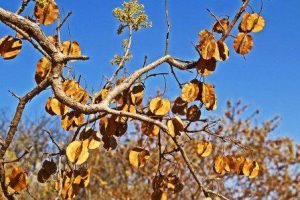
Combretum elaeagnoides. Photo: Meg Coates Palgrave. Source: Flora of Zimbabwe
The Bauhinia thonningii are covered with a heavy crop of fruit, still light green and unripe, and there are berries on the Cassine schlechteriana. The Tamarindus indica are still full of their tart, spicy fruits. The Friesodielsia obovata are just about finished fruiting, but the Diospyros senensis are still going, and their acorns are being eaten even by the Black-eyed Bulbul, toppie. Somewhere the Balanites maughamii must be dropping their oval fibrous seeds, as there are plenty of them in the elephant dung.
Other species seem to have decided that spring is already here, despite the cold nights (11 degrees C). More and more of the Kigelia africana are showing their candelabra flower stems, with the deep crimson blooms that are a delicacy for the bushbuck and other animals. The Kigelia have also started to loose some of their leaves. One of the Trichilia emetica in the camp has already adorned itself with tight clusters of creamy buds – very early.
In the evenings we have noticed the ‘potato’ smell which indicates that the Phyllanthus reticulates are in flower.
A note about the river channels and backwaters – the late rains this year flushed out these areas, greatly reducing the amount of water hyacinth (Eichornia crassipes – or exotic). On the other hand mats of Azolla nilotica have developed on the water surface this year.
-EB/VS/JS/DW
DICK HICKS CHAIRMAN


